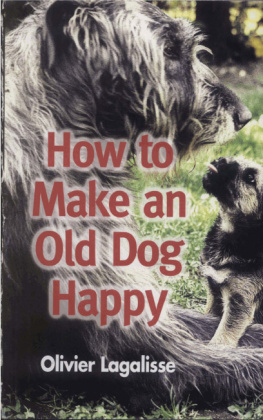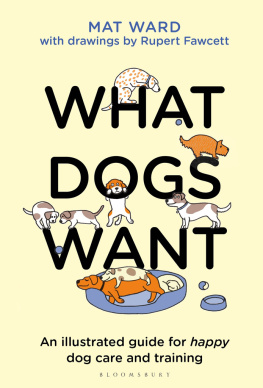Is your dog happy? How do you know? Studies have shown that many owners incorrectly interpret their dogs behaviour and emotions. Making Dogs Happy will ensure youre being a good human to your furry companion. Learn what motivates your particular dog and you can train them accordingly, making your dog as happy as they make you.
CONTENTS
INTRODUCTION
Making Dogs Happy is an informal look at the science behind making our canine pals as happy as they make us. We have referred to scientific research wherever it is relevant and available (references to our research are on ).
It is difficult to refer to what dogs, as a collective, like and dislike and how they behave. Just like humans, dogs have their own personalities and learned preferences, so they can differ dramatically in how they approach life and what they take from it. Any researcher who has worked with animals knows that whenever we think we understand the way they behave, there will be individual animals who buck the trend; individuals who did not read our textbooks and who are marching to the beat of their own drum. We have tried to address this wide range of variables in Making Dogs Happy by providing information on how to observe and understand dog body language and behaviour. This is one of the cornerstones of what we call dogmanship and will allow readers to ask of their own dog: How relevant is this to you?
We have suggested ways to test assumptions about the reasons our dogs do what they do, because it is always worth asking ourselves: How can I tell if Im right? Flexibility in our behaviour with dogs, and accepting that there might be a better approach than the one we like most, are hallmarks of good dogmanship.
We hope this book will empower dog owners to appreciate what their dogs might be feeling from moment to moment, and have strategies ready to respond in ways that support their dogs. Not only does this help head off problem behaviour in dogs, but it also fosters a rich and fulfilling humandog relationship. We mention our free app, doglogbook , on several occasions when we see particular merit in monitoring and recording your dogs behaviour. Veterinarians around the world are asking owners to use doglogbook to collect data on behaviour of clinical importance. You can download the app at www.doglogbook.com.
We have threaded stories from our own experiences of living with dogs throughout the book to provide examples and to share some of our own joy. We are not perfect dog owners, nor are our dogs perfect. Embracing the ways they can both surprise and vex us is part of enjoying the unique aspects of sharing your life with another species.
You will get to know our own dogs a little bit through these pages. (Not enough to fall in love with them because if you knew the full scope of their delightful personalities you would surely want them for yourselves and then they would be celebrities and people would stop us in the street to take selfies with our dogs.)
This book also features photographs that illustrate aspects of dog behaviour and humandog interactions and how to interpret them. There is a good deal of information and scientific research we would have loved to share in more detail, but this is not a comprehensive text. Making Dogs Happy is focused on the practical application of current theory to improve your relationship with your dog and, of course, in the process to make your dog happy.
The following pages feature a rundown of the humans and dogs involved in the writing of this book. We urge you to dive in and embrace our scientist/dog-lover hybridised approach to making dogs happy.
Melissa and Paul

Terminally curious and passionate animal lover Melissa knows that watching animals behave is like being invited into their world for a few moments. It is wondrous, fascinating and always raises questions. Melissa discovered in early high school that it is possible to make a career out of this. At university, studying zoology, it became apparent to her that no matter how much is learned about animal behaviour, it continues to be an exciting puzzle with only some of the pieces present. She hopes to be puzzled for the rest of her life.
 Nine-year-old Finnish lapphund and probably the best dog in the world, occasional social genius, regular comedian, frequent slightly animated floor rug and casual religious figure, Kivi is a very easy dog to live with and hard to imagine life without.
Nine-year-old Finnish lapphund and probably the best dog in the world, occasional social genius, regular comedian, frequent slightly animated floor rug and casual religious figure, Kivi is a very easy dog to live with and hard to imagine life without.
 Middle-aged Swedish vallhund Erik is the TAGS (Talented And Gifted Student) dog, who finds mischief wherever he goes. The smartest dog we know, Erik is quirky, highly alert, optimistic, always on the lookout for opportunity and apparently obsessed with cause and effect. He likes his world arranged just so and has spent years studying doors in particular, which doors should be opened and which kept closed.
Middle-aged Swedish vallhund Erik is the TAGS (Talented And Gifted Student) dog, who finds mischief wherever he goes. The smartest dog we know, Erik is quirky, highly alert, optimistic, always on the lookout for opportunity and apparently obsessed with cause and effect. He likes his world arranged just so and has spent years studying doors in particular, which doors should be opened and which kept closed.
 Young Portuguese podengo pequeno Kestrel is a tiny hound and at times a spitfire. She is fond of vertical space, running very fast, swallows, novel environments, cuddles and embracing a healthy Mediterranean diet. She could be part-weasel. She is exceptionally good at inventing new games for humans to play with her; however, human cooperation is encouraged, but not required.
Young Portuguese podengo pequeno Kestrel is a tiny hound and at times a spitfire. She is fond of vertical space, running very fast, swallows, novel environments, cuddles and embracing a healthy Mediterranean diet. She could be part-weasel. She is exceptionally good at inventing new games for humans to play with her; however, human cooperation is encouraged, but not required.


For veterinarian and animal watcher Paul, a walk is hardly worth taking unless there is at least one dog in tow. As a teenager, Paul competed his dogs in agility and obedience trials, learning very quickly that simple technique was not all that mattered. He discovered that when we attempt to communicate with dogs what lies beneath is truly enthralling. His fascination with dogs is matched by his love of horses. Pauls behavioural studies of horses and their humans have helped bring about the scientific study of equestrian technique, so-called equitation science. He now uses the same approaches to reveal the secrets of dogmanship.

















 Nine-year-old Finnish lapphund and probably the best dog in the world, occasional social genius, regular comedian, frequent slightly animated floor rug and casual religious figure, Kivi is a very easy dog to live with and hard to imagine life without.
Nine-year-old Finnish lapphund and probably the best dog in the world, occasional social genius, regular comedian, frequent slightly animated floor rug and casual religious figure, Kivi is a very easy dog to live with and hard to imagine life without.
